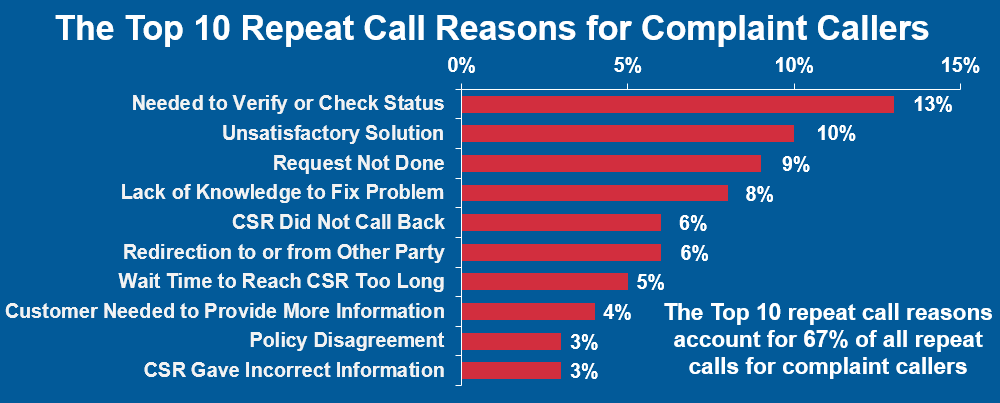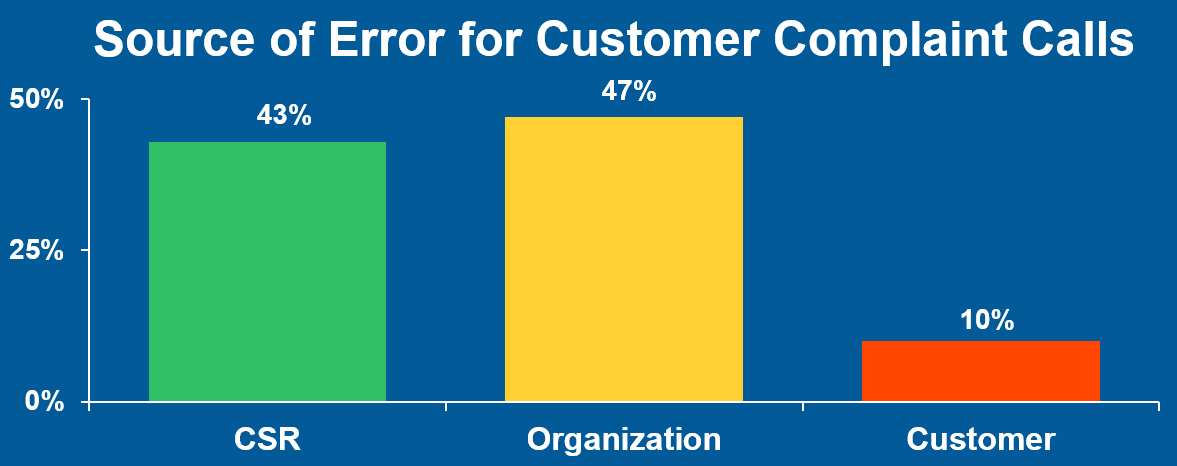
Top 10 Repeat Call Reasons for Complaint Callers
Shhh! SQM’s research shows that 14% of customers who call a contact center define their call as a complaint. In fact, most contact centers believe that their customer complaint calls are less than 5%. It is SQM’s experience that complaint calls are significantly underreported.
Most contact centers are not effective at handling customer complaint calls. Given that most contact centers do not have a complaint call definition, it is no surprise that they are inconsistent in identifying, tracking, and resolving customer complaint calls.
SQM believes that when a customer expresses dissatisfaction, it should be viewed and documented in the customer relationship management as a customer complaint call.
SQM’s research also shows that the average Csat (top box response) is 55% for customers who define their call as a complaint, versus non-complaint callers whose average Csat (top box response) is 82%. The average Net Promoter Score® (NPS®) for complaint callers is -16% versus non-complaint callers with an NPS® of 45%.
Clearly, poor complaint call handling results in negatively impacting Csat and referrals, and therefore, customer complaint calls are a big issue!
Based on SQM’s research, the below figure shows the top 10 repeat call reasons, which accounts for 67% of all repeat calls for complaint callers.
Many contact center managers think that the wait time being too long to reach a CSR is their number one customer complaint issue. Interestingly, the wait time to reach a CSR only accounted for 5% of the repeat call reasons for complaint callers.
SQM’s customer complaint research shows that a customer having to call back to have their inquiry or problem resolved is the real driver of customer complaints.
It is important to understand that first call resolution for the contact center industry is at 71%. Therefore, 29% of customers have to call back. It is equally important to understand that customers do not want to call back. Furthermore, SQM’s research shows that 93% of customers expect that when they call a contact center, their call will be resolved on the first call.
Based on conducting over 500 Voice of the Customer (VoC) call center FCR benchmarking studies, figure 1 shows that FCR is 19% lower for customers transferred to an escalation Agent than customers who were not transferred to an escalation queue. The main reason why FCR performance is lower is that escalated calls tend to be more complex than non-escalated calls, and the Agent escalation queue is mismanaged. Agent support queue is the last line of defense in many cases for resolving a complex call or a customer complaint.
The top reasons why many customers are calling back are because they needed to verify or check the status of their inquiry or problem, they were not satisfied with the solution the CSR provided, their request was not done, the CSR lacked the knowledge to fix the customer’s problem, or the CSR did not call back when they said they would.

Another key finding of SQM’s customer complaint research is that when customers felt the CSR had a poor attitude, most customers asked to be transferred to a supervisor versus hanging up and calling back to speak to a different CSR.
A customer complaint should be viewed as a gift because you can provide service recovery and/or improve customer experience. Furthermore, it is five to ten times more costly for the organization to attract new customers than it is to retain existing customers.
When we examined the source of error (SoE) for creating customer complaint calls, we discovered that the CSR was the SoE 43% of the time and the organization was the SoE 47% of the time (see below figure).

It has been SQM’s experience that most customer complaint call handling improvements are a result of improving CSR SoE issues, as CSR SoE is typically easier to improve than organization SoE issues. However, organization SoE represents the biggest opportunity for reducing customer complaints. Many contact centers operate in a siloed manner and, as a result, they seldom focus their customer complaint improvement efforts on areas that involve people, process, and technology practices for which they do not have ownership.
The contact center needs to be able to assist in improving the organization’s practices in which they traditionally do not have ownership to reduce customer complaints.
Quick Related Links
First Call Resolution Definition First Call Resolution PPT First Call Resolution Benefits Employee Engagement First Call Resolution Operating Philosophy Call Handling Best vs Worst Agents Helpdesk Case Study Celebrating Agent Success VoC Performance Mgmt Helpdesk What is a Good FCR Rate? VoC Closed-Loop Top 10 CX Metrics Agent Coaching and Recognition
